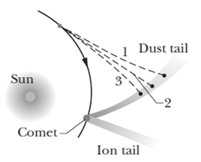In the figure, light enters a triangular prism at point with incident angle and then some of it refracts at point with an angle of refraction of (a) What is the index of refraction of the prism in terms of (b) What numerically is the maximum value that the index of refraction can have? Does light emerge at if the incident angle at is, (c) increased slightly and (d) decreased slightly? (e) What is the incident angle if the index of refraction is



Important Questions on Electromagnetic Waves
In the figure (a), unpolarized light is sent into a system of three polarizing sheets. The angles and of the polarizing directions are measured counterclockwise from the positive direction of the -axis (they are not drawn to scale). Angles and are fixed, but angle can be varied. Figure (b) gives the intensity of the light emerging from sheet as a function of . (The scale of the intensity axis is not indicated.) What percentage of the light's initial intensity is transmitted by the system when
(a)
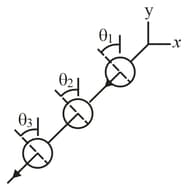
(b)

When the rectangular metal tank in the figure is filled to the top with an unknown liquid, observer with eyes level with the top of the tank, can just see corner A ray that refracts toward at the top surface of the liquid is shown. If and what is the index of refraction of the liquid?
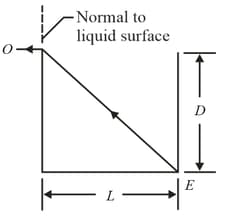
In the figure (a), unpolarized light is sent into a system of three polarizing sheets. The angles and of the polarizing directions are measured counterclockwise from the positive direction of the -axis (they are not drawn to scale). Angles and are fixed, but angle can be varied. Figure (b) gives the intensity of the light emerging from sheet as a function of . (The scale of the intensity axis is not indicated.) What percentage of the light's initial intensity is transmitted by the three-sheet system when
(a)
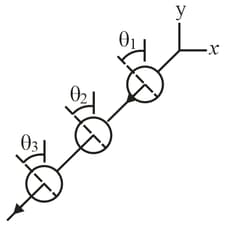
(b)

In the figure, an unpolarized light is sent into a system of three polarizing sheets which transmits of the initial light intensity. The polarizing directions of the first and third sheets are at angles and What are the (a) smaller and (b) larger possible values of angle for the polarizing direction of sheet

In the figure, a ray is incident on one face of a triangular glass prism in air. The angle of incidence is chosen, so that the emerging ray also makes the same angle with the normal to the other face. Show that the index of refraction of the glass prism is given by,
where is the vertex angle of the prism and is the deviation angle, the total angle through which the beam is turned in passing through the prism. (Under these conditions the deviation angle has the smallest possible value, which is called the angle of minimum deviation.)

Suppose the prism of the figure (a) has apex angle and index of refraction (a) What is the smallest angle of incidence for which a ray can enter the left face of the prism and exit the right face? (b) What angle of incidence is required for the ray to exit the prism with an identical angle for its refraction, as it does in the figure (b)?
(a)
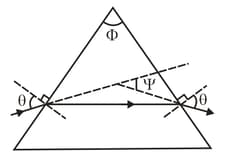
(b)
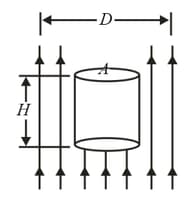
As a comet swings around the sun, ice on the comet's surface vaporizes and releasing trapped dust particles and ions. The ions, because they are electrically charged are forced by the electrically charged solar wind into a straight ion tail that points radially away from the sun (see figure). The (electrically neutral) dust particles are pushed radially outward from the sun by the radiation force on them from sunlight. Assume that, the dust particles are spherical, have density and are totally absorbing. (a) What radius must a particle have in order to follow a straight path like path in the figure? (b) If its radius is larger, does its path curve away from the sun (like path ) or towards the sun (like path )?
